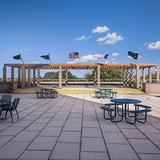- Nassau Community College, a constituent member of the State University of New York system, is a comprehensive, full-opportunity institution of higher education. The College is dedicated to high quality, low-cost education and career preparation to meet the needs and interests of the community it serves. It is committed to academic excellence and the dignity and worth of the individual. To this end, Nassau Community College offers Associate in Arts, Associate in Science, and Associate in Applied Science degrees, as well as certificates and continuing education programs. Its curricula span the liberal arts and sciences, as well as pre-professional and professional areas, for the benefit of a diverse population. The College places a high priority on small classes, taught by qualified, experienced faculty, to provide an optimal educational environment.
School Highlights
Nassau Community College serves 17,203 students (44% of students are full-time).
The college's student-teacher ratio of 13:1 is same as the state community college average of 13:1.
Minority enrollment is 68% of the student body (majority Hispanic), which is more than the state average of 62%.
Quick Facts (2025-26)
- Enrollment: 17,203 students
- In-state tuition: $4,739
- Out-state tuition: $8,973
- Student-teacher ratio: 13:1
- Minority enrollment: 68%
- Source: Integrated Postsecondary Education Data System (IPEDS)
Top Rankings
Nassau Community College ranks among the top 20% of public schools in New York for:
School Overview
The teacher population of 1,370 teachers has stayed relatively flat over five years.
Nassau Community College
(NY) Community College Avg.
Carnegie Classification
Associate's Colleges: High Transfer-High Traditional
Baccalaureate/Associate's Colleges: Mixed Baccalaureate/Associate's
Institution Level
At least 2 but less than 4 years
At least 2 but less than 4 years
Institution Control
Public
Private not-for-profit
Total Faculty
1,370 staff
159 staff
School Calendar
Student Body
The student population of Nassau Community College has stayed relatively flat over five years.
The student-teacher ratio of 13:1 has increased from 10:1 over five years.
The Nassau Community College diversity score of 0.75 is less than the state average of 0.76. The school's diversity has stayed relatively flat over five years.
Total Enrollment
17,203 students
1,129 students
Student-Teacher Ratio
13:1
13:1
# Full-Time Students
7,587 students
528 students
# Part-Time Students
9,616 students
601 students
# Enrollment Undergraduate
172 students
357 students
# Full-Time Undergraduate Students
7,587 students
519 students
# Full-Time Graduate Students
n/a
44 students
# Part-Time Undergraduate Students
9,616 students
850 students
# Part-Time Graduate Students
n/a
41 students
Total Dormitory Capacity
n/a
382 students
% American Indian/Alaskan
n/a
n/a
% Asian
9%
8%
% Hispanic
30%
23%
% Black
19%
18%
% White
32%
38%
% Hawaiian
n/a
2%
% Two or more races
2%
3%
% Non Resident races
1%
3%
% Unknown races
7%
5%
Diversity Score
0.75
0.76
College Completion Rate (Students who graduate in less than 4 years)
21%
33%
College Completion Rate (Students who graduate in 4 years or more than 4 years)
n/a
40%
Average Graduate Earnings (10 Years)
$42,000
$35,200
Tuition and Acceptance Rate
The public in-state tuition of $4,739 is less than the state average of $5,902. The in-state tuition has declined by 25% over four years.
The public out-state tuition of $8,973 is less than the state average of $10,404. The out-state tuition has declined by 26% over four years.
In-State Tuition Fees
$4,739
$5,902
Out-State Tuition Fees
$8,973
$10,404
% Students Receiving Some Financial Aid
81%
88%
Median Debt for Graduates
$10,500
$13,841
Median Debt for Dropouts
$5,500
$5,500
Acceptance Rate
n/a
74%
SAT Reading
n/a
475
SAT Math
n/a
505
SAT Writing
n/a
485
ACT Composite
n/a
20
ACT English
n/a
18
ACT Math
n/a
20
Source: 2024 (or latest year available) Integrated Postsecondary Education Data System (IPEDS)
School Notes
- Nassau Community College was created as part of the State University of New York by the Nassau County Board of Supervisors on February 9, 1959. When the College opened in a wing of the County Court House in Mineola on February 1, 1960, it had only 632 students. Enrollment increased dramatically after 1962, when classes were moved to spacious facilities at the former U.S. Air Force base at Mitchel Field. Nassau, the largest of SUNY's 30 community colleges, enjoys a nationwide reputation for academic excellence and ease of transferability to four-year schools. Nassau�s faculty is one of the best in New York State, having a higher than average number of Ph.D's and one of the lowest teacher/student ratios. The modern campus includes a library with sophisticated audio-visual facilities and classroom/laboratory wings equipped with personal computers and state-of-the-art apparatus for instruction in more than 60 different fields of study in business, fine & performing arts, health related sciences, liberal arts & sciences, mathematics / computer processing, natural sciences, engineering technologies and social sciences. Expert coaching in the finest indoor and outdoor athletic facilities has made the men's and women's varsity teams at Nassau a dominant force in the National Junior College Athletic Association. Individual athletes have gone on to prominence at senior colleges and universities, as well as in professional sports and as coaches and physical education teachers. The College is fully accredited by the Middle States Association of Colleges and Schools and is authorized by the N.Y. State Board of Regents to award two-year Associate Degrees in Arts (A.A.), Science (A.S.), and Applied Science (A.A.S.).
Frequently Asked Questions
How much does Nassau Community College cost?
Nassau Community College's tuition is approximately $4,739 for In-State students and $8,973 for Out-State students.
What is Nassau Community College's ranking?
Nassau Community College ranks among the top 20% of community college in New York for: Diversity in US community colleges and Largest student body.
Recent Articles

The Rise of Technical and Vocational Training in 2025
Explore the 2025 surge in technical and vocational training—enrollment, policy, costs, and why this path is gaining ground for students and parents.

Stackable Credentials: How Community Colleges Advance Careers
Discover how community colleges use stackable credentials to build career pathways, boost earnings, and enable lifelong learning in 2025.

High-Paying Jobs You Can Get with a Community College Degree
Discover top high-paying careers you can launch in 2025 with a community college (associate) degree and high-growth credentials in tech, healthcare and trades.











